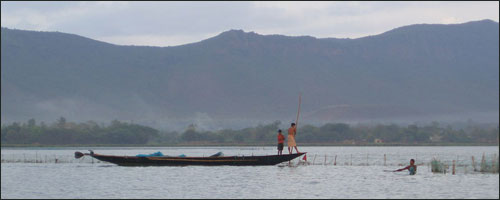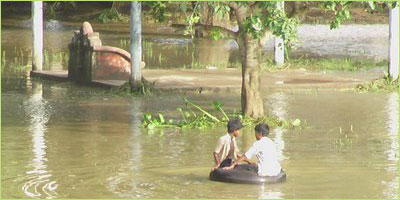CHILKA LAKE: ORISSA
The largest brackish-water lake in the Indian religion. It bas a maximum area of
116,500 ha (1,165 sq km) in the rains. It decreases in about 90,000 ha in the
dry summer months. A very shallow lake, it is separated from the Bay of Bengal
by a
 narrow sandy ridge, but remains connected to the Bay via a channel. It receives
fresh water from the Daya river, a deltaic branch of the Mahanadi and from local
streams. The salinity levels vary in different parts of the lake, depending upon
die monsoon inflow.
narrow sandy ridge, but remains connected to the Bay via a channel. It receives
fresh water from the Daya river, a deltaic branch of the Mahanadi and from local
streams. The salinity levels vary in different parts of the lake, depending upon
die monsoon inflow.
Chilka is beset by an alarming amount of problems, the most serious being siltation.
According to the Remote Sensing Organisation (ISRO) the original
extent of this lake was some 2,200 sq km. Today the lake has shrunk 916 sq km.
Of this, 400 sq km is occupied by weeds and suffers from very heavy sedimentation,
so that the actual lake spread is barely 556 sq km. Siltation, of course, has
been largely due to the mindless erosion in the surrounding hills. Along with
the increasing siltation, is the decreasing salinity and the great spread of
the aquatic plant Potamogeton pectinatus.
The channel connecting Chilka to the
Bay of Bengalis also getting hopelessly choked, favouring the spread of Potamogeton
because of the falling salinity. In 1982, a remote sensing study conclusively
showed that this weed covered nearly 20,000 ha of the lake area, a ten-fold
increase over the past decade. Such danger signals seem to have no affect on
the powers that be in Orissa, who spend their time politicking in Delhi, more
than in looking after the ancient natural heritage of this once-rich state.
With an abject lack of political support for conservation, the problem of poaching
was bound to become intense. More than 100,000 people from over 100 surrounding
villages over-fish and poach between 15,000 and 20,000
waterfowl annually. Increasing
numbers of livestock has gradually been degrading the reedy and shallow margins
of the lake, as also some of the islands. Encroachment; on the margins for agricultural
expansions, are also severe, as also is the danger from pollution (effluent
discharge) from agricultural and industrial activities. The hard pressed locals
cannot be blamed for what is clearly an administrative responsibility.
The Orissa government has virtually left its people to their own devices and
they cannot therefore act in concert through their elected leaders to manage
the vast area.
Nevertheless, Chilka has been at the forefront of environmental awareness and
conservation work for nearly two decades now, thanks to the efforts of naturalists
and some aware locals. In 1973, the entire lake area was accorded Sanctuary
status, and a core area declared. Chilka is one of the two Ramsar sites of India.
Hunting and night fishing have been completely banned since 1986... at least
on paper. The lake is controlled by the Orissa State Wildlife Department which
given its adverse circumstances is doing a good job of protection. This is also
one of the sites selected for conservation and management by the National Weiland
Management Committee (NWMC).
More than 700 tonnes of fish are caught annually at Chilka, mostly prawns and
fin-fish. Considerable income is thus generated from fishing leases. Around
118 species of fish have been identified from the lake, besides commercially
important species of prawns, shrimps and crabs. Investing in the restoration
of Chilka to its former health would be the most practical long-term development
plan for the region.
Despite its problems, this immense water body is regarded by many as one of
India’s most splendid winter refuges for waterfowl. The 1989 AWC recorded
nearly 217,000 waterfowl, mostly duck, from and around Nalban Island in the
lake. The 1990 AWC for Chilka was over 480,000 waterfowl, the highest for any
one site in the Indian region, though some suggest the figures for a few species
may have been exaggerated. On the other hand, however, with more than 150 bird
species having been recorded and considering the vast spread of die lake, the
population of many important breeding species may not have been properly enumerated
either. Interestingly, there have been reports of dugongs from the area.
 narrow sandy ridge, but remains connected to the Bay via a channel. It receives
fresh water from the Daya river, a deltaic branch of the Mahanadi and from local
streams. The salinity levels vary in different parts of the lake, depending upon
die monsoon inflow.
narrow sandy ridge, but remains connected to the Bay via a channel. It receives
fresh water from the Daya river, a deltaic branch of the Mahanadi and from local
streams. The salinity levels vary in different parts of the lake, depending upon
die monsoon inflow.